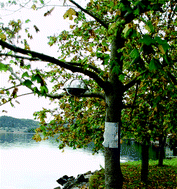Using passive air samplers to assess local sources versus long range atmospheric transport of POPs†
Abstract
Passive air samplers (

* Corresponding authors
a
Norwegian Institute for Air Research, Box 100, NO-2027 Kjeller, Norway
E-mail:
kbr@nilu.no
b Lancaster Environment Centre, Lancaster University, Lancaster, UK
c University of Oslo, Department of Chemistry, Box 1033, NO-0315 Oslo, Norway
Passive air samplers (

 Please wait while we load your content...
Something went wrong. Try again?
Please wait while we load your content...
Something went wrong. Try again?
A. K. Halse, M. Schlabach, A. Sweetman, K. C. Jones and K. Breivik, J. Environ. Monit., 2012, 14, 2580 DOI: 10.1039/C2EM30378G
To request permission to reproduce material from this article, please go to the Copyright Clearance Center request page.
If you are an author contributing to an RSC publication, you do not need to request permission provided correct acknowledgement is given.
If you are the author of this article, you do not need to request permission to reproduce figures and diagrams provided correct acknowledgement is given. If you want to reproduce the whole article in a third-party publication (excluding your thesis/dissertation for which permission is not required) please go to the Copyright Clearance Center request page.
Read more about how to correctly acknowledge RSC content.
 Fetching data from CrossRef.
Fetching data from CrossRef.
This may take some time to load.
Loading related content
